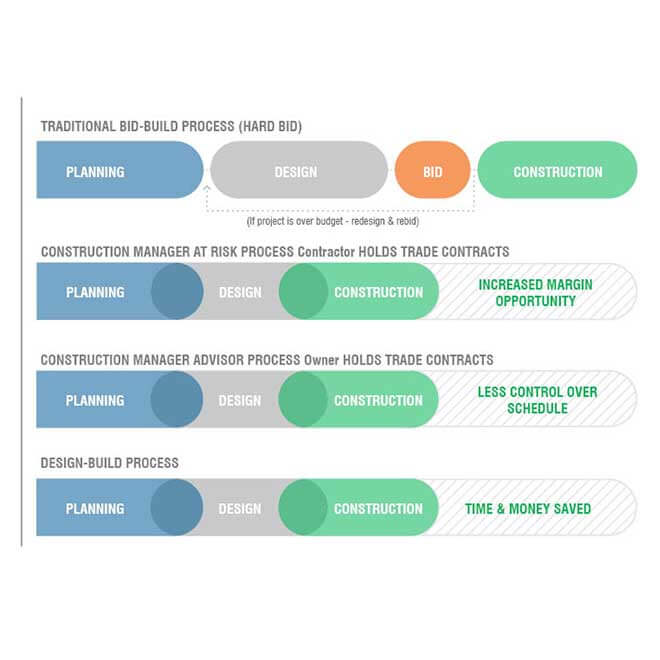
Construction procurement methods or delivery types have evolved over the years with economic times, trends, and clear understanding of each style. Often the delivery type is chosen based on previous experience, our goal is to broaden the understanding of each type from a very high level. Generally, there are four delivery methods chosen in the commercial construction industry: Design-Bid-Build, Construction Manager at Risk, Construction Manager Advisor, and Design Build. We have included a brief description of each, with several pros and cons highlighted, focusing on the timing of the general contractor’s involvement in the process.
Design-Bid-Build (Hard Bid): The project is fully designed, and plans are given to unknown general contractor (GC) to review all scope and bid out projects. Low bid wins with little to no input from GC early on.
Pros:
- Initial cost savings from competitive bid environment may be realized.
- Perception of forced subcontractor competition.
- High risk of change orders and RFI’s.
- GC has little input on constructability, which could lead to quality issues and re-work.
- Reduced margin opportunity.
- Any savings generally stay with the GC.
Construction Manager at Risk (CMaR): Strong relationship with GC as they are early in design phase via a negotiated or RFP process. GC assists with cost estimating, scheduling, and a guaranteed maximum price (GMP) is set before design complete/construction start.
Pros:
- Open book on financials.
- Pre-qualified subcontractors with a proven track record and reliability.
- Quality control and schedule not an issue.
- Early involvement by the GC helps us to understand owner priorities, this alignment helps to deliver a quality project that encourages repeat work.
- Increased margin opportunity.
Cons:
- Cost savings is seen during and at completion of the project not initially.
- Educating owners on this procurement style, and making them comfortable with the process.
Construction Manager Advisor (CMa): A hybrid of the above two delivery methods, the GC is brought on during design via a relationship driven process or RFP with the ability to impact scope and schedule. Once hired bid packages are set, and low subcontractor bid wins on bid day, owner holds the contracts with GC overseeing all trades as a single point of contact.
Pros:
- Initial constructability review and trade coordination.
- Open financials, savings returned to owner.
Cons:
- Slight risk of being over budget, final contract value unknown on bid day.
- Greater owner involvement, leading to administration cost.
- Less control over schedule.
Design Build: The design team and general contractor are hired simultaneously early on or the team partnered prior to selection due to a long-standing relationship and shared experience.
Pros:
- Contractual structure helps to ensure constructability and quality.
- Opportunity to develop strong connections with Design firms. This could lead to future work.
- Design team and GC working together from the start to stay within budget.
Cons:
- Increased time and resources for preconstruction services.
- Many municipalities or funding sources allow Design Build as a procurement method.
The goal of all four methods is to bring every project in on time and under budget, each procurement process achieves this goal uniquely. Our goal at AP is to educate clients and provide them the information necessary to select the delivery method that aligns with their needs while building trust and ongoing relationships for future work.



